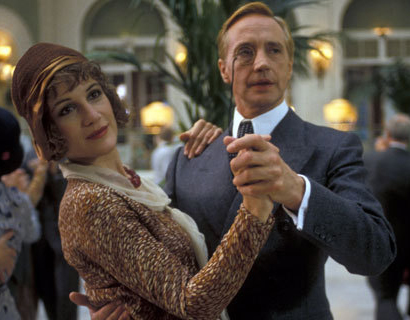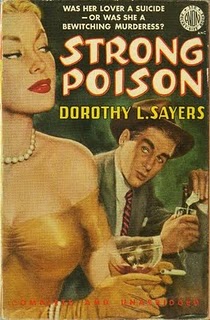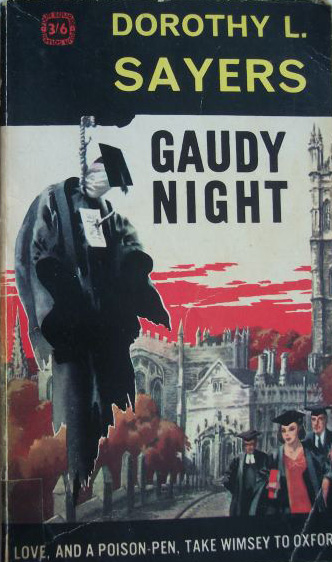
There are eleven Wimsey novels, twelve if you count the unfinished Thrones, Dominations (later completed by Jill Paton Walsh), and a variety of short stories. However, discounting the latter, Harriet appears in only four novels, with only slight reference to her in a fifth, not discussed here. The big four are Strong Poison (1930), Have His Carcase (1932), Gaudy Night (1936), and Busman’s Honeymoon (1937). If you don’t want to commit to the whole series, those four novels more than satisfy. The main reason I love these four in particular is because they’re about more than mystery. I consider them feminist novels.
Before the advent of Harriet, Lord Peter Death Bredon Wimsey was already a great character. After Harriet’s falsely accused of murder, and Lord Peter decides to prove her innocence, he attains significantly more depth and humanity. The complexity of the books burgeons towards the end of the series. There is always, of course, the mystery. But there’s also the growing and deepening relationship between Peter and Harriet, and there are feminist and class issues, explored through Harriet’s point of view about herself in comparison to Lord Peter.
Here are the basics: Lord Peter wants to marry Harriet almost immediately after meeting then exonerating her. Harriet, however, feels she cannot, simply because he saved her from being convicted of murder. Aside from that, he is a wealthy aristocrat, and she is a middle-class writer of detective fiction. Lord Peter is persistent, both in seeing her and in proposing marriage. They go on to solve more mysteries together. Gradually, they begin to realize exactly how much they have in common and how much they are attracted to each other, but the reasons to resist marriage, at least on Harriet’s part, continue.

Harriet’s refusal establishes her as a character equal to Lord Peter, perhaps even stronger, since she comes from a weaker position in society. Harriet is not in very many scenes in Strong Poison, and her point of view isn’t given. What we-the-readers get is Peter’s view of her, a woman outside of social norms. Through his opinions, we not only learn about Harriet, but we learn more about Peter than we’ve ever known before. It’s new, it’s exciting, it’s fascinating. We have to know what happens to them.
Have His Carcase is the first time we’re given Harriet’s point of view, and it’s also the point when her attraction to Peter becomes very clear, as does her own self-doubt, and her fears about what would happen to her if she married him. She begins to see Peter as a person in this novel, and so do we, the readers. Peter shows that he sees her, too, as a specific person whom he thinks about romantically, for instance when he suggests she should buy a wine-colored frock because “It suits people with honey-colored skin.” Harriet demands to know if the wine should be the color of port or sherry. He promptly responds, “Claret. . .Chateau Margaux 1893 or thereabouts.”

In the end, Peter doesn’t convince her to marry him at all. She convinces herself that she can.
Busman’s Honeymoonbegins with their marriage and honeymoon, and is very satisfying indeed after all the emotional struggles of the previous three novels. It only deepens the emotional issues the couple faces now that they’ve committed to each other. To me, Lord Peter Wimsey and Harriet Vane represent the greatest couple within a mystery series, but if you have other suggestions. . .I always love investigating a new romance.
Victoria Janssen is the author of three erotic novels and numerous short stories. Her latest novel is The Duke and The Pirate Queen from Harlequin Spice. Follow her on Twitter: @victoriajanssen or find out more at victoriajanssen.com.

The other debate in Gaudy Night is Harriet’s temptation to return to the cloistered world of Cambridge as an academic which would seal her independence and respectability but could be seen as running away from not only her past, but also Wimsey and the outside world. She is only willing to be with Peter when she is confident that they will be equals but also, I suspect, that she is at last able to get over her personal past.
This is, I agree, a deeply feminist novel about a period of change in English society.
@a-j , I also love that aspect of the novel – the community Harriet finds with her fellow academics. It’s as if she sees one paradise there, and another potential paradise with Peter.
Like you, @VictoriaJanssen, I read the Sayers books in middle school. Unlike you, however, I never returned to them after devouring them. I think I should, I will likely get a much better reading of them after so many years.
@Victoria Janssen, this is an excellent post!! I read some Sayers in random order a few years ago, before I read PD James and Elizabeth George. I liked her prose, but couldn’t get into the characters. I have a feeling now that I’ve read James and George, I’ll have a better understanding of Sayers’ books.
@MFrampton, you should totally re-read them!
@KeiraSoleore, I was a big fan of P.D. James, too, though I never read the most recent ones in the Dalgliesh series. Character-wise, I think the ones with Harriet are the best. My favorites without Harriet are Clouds of Witness, The Unpleasantness at the Bellona Club, and Murder Must Advertise.
I also began reading Sayers in the sixth grade or so and consider the Lord Peter novles the gold standard for writing a mystery series that includes a romantic theme over several book. That being said, if you love mysteries, especially “golden age” British mysteries, you really should try to read them all, and read the short stories as well (one of which, Talboys, involves Harriet and Peter and their three sons).
I re-read Gaudy Night every year. The issues and themes Sayers touches on are timeless, and I think the final proposal is perhaps one of the most romantic proposals ever.
Also, there’s more to Sayers than just her mysteries — she is quite respected for her scholarly work, and she worked in advertising for some time — she was the copywriter on the Guinness Toucan ads (her little rhyme is the one that morphed the original Guinness Pelican into the Guinness Toucan).
Lord Peter Wimsey, my first crush on a literary figure. Read every short story and novel Dorothy Sayers wrote with this hero. I am with you, @Victoria Janssen, love all of the works with Harriet and Lord Peter because I’ve always felt that Sayers was just playing with Lord Peter’s character even though his bouts of inanity were explained by his WWI experience, but when Harriet came along, she was such a stong personality that she forced Sayer to rethink making Lord Peter her equal. Funny what a strong woman can do!
I, too read the Sayers novels in middle school, and they affected me deeply.
I am now almost 30 years married to a smart man who likes me because I’m smart- not in spite of, like my previous swains. And we’ve fought to have an egalitarian relationship. I credit Sayers with much of my stubbornness to hold out for this.
@Nora, @Louise321, @Cissa, thanks! I am really wanting to re-read some of my Sayers now. It’s been a few years since I’ve done so. Maybe it’s time.
Thnaks for Shaering it